
Weevils are beetles belonging to the superfamily Curculionoidea, known for their elongated snouts. They are usually small – less than 6 mm in length – and herbivorous. Approximately 97,000 species of weevils are known. They belong to several families, with most of them in the family Curculionidae. It also includes bark beetles, which while morphologically dissimilar to other weevils in lacking the distinctive snout, is a subfamily of Curculionidae. Some other beetles, although not closely related, bear the name "weevil", such as the biscuit weevil, which belongs to the family Ptinidae.
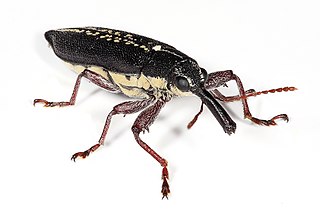
Belidae is a family of weevils, called belids or primitive weevils because they have straight antennae, unlike the "true weevils" or Curculionidae which have geniculate (elbowed) antennae. They are sometimes known as "cycad weevils", but this properly refers to a few species from the genera Parallocorynus and Rhopalotria.

Brentidae, sometimes known as the primitive weevils, is a cosmopolitan family of primarily xylophagous beetles also known as straight-snouted weevils. The concept of this family has been expanded with the inclusion of three groups formerly placed in the Curculionidae; the subfamilies Apioninae, Cyladinae, and Nanophyinae, as well as the Ithycerinae, previously considered a separate family. They are most diverse in the tropics, but occur throughout the temperate regions of the world. They are among the families of weevils that have non-elbowed antennae, and tend to be elongate and flattened, though there are numerous exceptions.
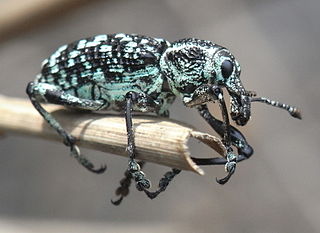
Chrysolopus spectabilis is a species of weevil found in south-eastern Australia. It was discovered during James Cook's first voyage, and became one of the first insects to be described from Australia. The weevil measures up to 25 mm (1.0 in) long and includes distinctive metallic green and black scales. It is found only on 28 species of the plant genus Acacia.

The New Zealand giraffe weevil, Lasiorhynchus barbicornis, is a straight-snouted weevil in the subfamily Brentinae, endemic to New Zealand. L. barbicornis is New Zealand's longest beetle, and shows extreme sexual dimorphism: males measure up to 90mm, and females 50mm, although there is an extreme range of body sizes in both sexes. In males, the elongated snout can be nearly as long as the body. Male giraffe weevils use this long rostrum to battle over females, although small males can avoid conflict and 'sneak' in to mate with females, sometimes under the noses of large males. The larval weevils tunnel into wood for at least two years before emerging, and live for only a few weeks as adults.

Oxycorynini are a tribe of American belids, primitive weevils of the family Belidae. Like in other belids, their antennae are straight, not elbowed as in the true weevils (Curculionidae). In contrast to other Belidae, Oxycorynini larvae feed on flowers or several types of fruit.

Callosobruchus maculatus is a species of beetles known commonly as the cowpea weevil or cowpea seed beetle. It is a member of the leaf beetle family, Chrysomelidae, and not a true weevil. This common pest of stored legumes has a cosmopolitan distribution, occurring on every continent except Antarctica. The beetle most likely originated in West Africa and moved around the globe with the trade of legumes and other crops. As only a small number of individuals were likely present in legumes carried by people to distant places, the populations that have invaded various parts of the globe have likely gone through multiple bottlenecks. Despite these bottlenecks and the subsequent rounds of inbreeding, these populations persist. This ability to withstand a high degree of inbreeding has likely contributed to this species’ prevalence as a pest.

Naupactus is a genus of beetles in the weevil family Curculionidae, the true weevils. They are known commonly as whitefringed beetles. Many species of the genus are considered pests, both as larvae and as adults. The genus is native to the Americas, where it is distributed from Mexico to Argentina; the highest species diversity is in Brazil. Several species have been introduced to the United States and New Zealand.

Gonipterus gibberus is a species of weevil in the family Curculionidae. It is commonly known as the eucalyptus snout beetle, the eucalyptus weevil or the gum tree weevil. It feeds and breeds on Eucalyptus trees and is endemic to Australia.

Rhynchophorus, or common name palm weevils, is a genus of beetles in the weevil family, Curculionidae. Palm weevils are major pests of various trees in the family Arecaceae throughout the tropics including: coconut, Areca catechu, species of the genus Phoenix, and Metroxylon sagu. Two species are invasive pests outside their native ranges, Rhynchophorus ferrugineus and Rhynchophorus palmarum.
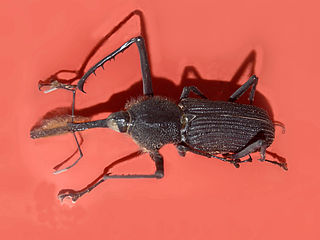
Rhinostomus is a genus of the true weevil family, Curculionidae and the monotypic tribe Rhinostomini. They include "yucca weevils" and were previously placed in a genus called Yuccaborus; in 2002, this was determined to be a taxonomic synonym of Rhinostomus, and the species, Y. frontalis, was moved to the genus Rhinostomus.

Hylastes ater is a species of beetle in the family Curculionidae, the true weevils. It is a bark beetle, a member of the subfamily Scolytinae. Its common name is the black pine bark beetle. It is native to Europe and parts of Asia, including China and Korea. It is known as an introduced species in many other regions, including Australia, New Zealand, the Americas, and South Africa. It is a pest of pines and other trees, and it is widespread in areas where pine trees are cultivated. The species "is an important threat to the biosecurity of all forested countries."
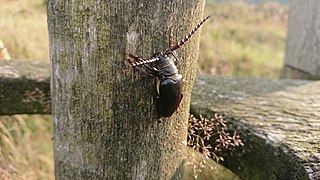
Prionus laticollis, also known as the broad-necked root borer or broad necked prionus, is a root-boring longhorn beetle described by Dru Drury in 1773. It is widespread throughout eastern North America: its range covers a vast swath from Quebec in the northeast to Arkansas in the southwest.
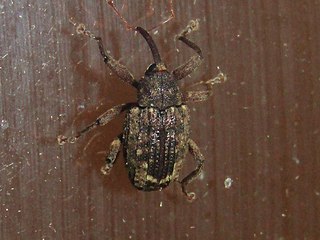
The Conotrachelus posticatus is a species of true weevil within the beetle family Curculionidae. C. posticatus is particularly found in North America. It is known to be about 3.7–5 mm (0.15–0.20 in) long, and it normally tends to be present in North America all the way to Panama. This species of Conotrachelus is able to breed in acorns; as a result, its larvae are found within acorns and their larval diet includes acorns. Their growing presence within oak trees has been studied and previously shown to attack oak trees by destroying the seeds within the tree. At times, the seeds can be found to be partially damaged, and there remain holes in the understanding surrounding the activity of the species in relation to oak trees.

Sicoderus bautistai is a species of weevil in the genus Sicoderus indigenous to the island of Hispaniola. It is closely related to the species S. ramosi, S. guanyangi, and S. turnbowi. Its appearance has been described as similar to that of "black, shiny ants".
Astycus cinnamomeus, is a species of weevil found in Sri Lanka.
Astycus immunis, is a species of weevil found in Sri Lanka.
Astycus lewisi, is a species of weevil found in Sri Lanka.
Sympiezomias kraatzi, is a species of weevil found in Sri Lanka.
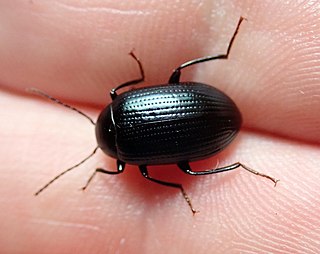
Amarygmus is a genus of darkling beetles. It is in the tribe Amarygmini and is the oldest genus of the tribe. The genus occurs in Australia, New Guinea, Hawaii, Africa and Eurasia.
















